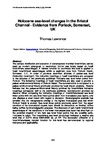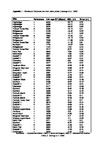Holocene sea-level changes in the Bristol Channel - Evidence from Porlock, Somerset, UK
| dc.contributor.author | Lawrence, T. | |
| dc.date.accessioned | 2019-05-14T08:17:09Z | |
| dc.date.available | 2019-05-14T08:17:09Z | |
| dc.date.issued | 2010 | |
| dc.identifier.citation |
Lawrence, T. (2010) 'Holocene sea-level changes in the Bristol Channel - Evidence from Porlock, Somerset, UK', The Plymouth Student Scientist, p. 233-280. | en_US |
| dc.identifier.issn | 1754-2383 | |
| dc.identifier.uri | http://hdl.handle.net/10026.1/13920 | |
| dc.description.abstract |
The surface distribution and elevation of contemporary intertidal foraminifera can be used as modern analogues to reconstruct former sea levels based on fossil foraminifera assemblages. A transfer function for southwest tide level is applied to fossil foraminiferal assemblages within a sediment core from Porlock Marsh, Somerset, U.K., in order to produce quantified altitudes of palaeo-sea level (‘indicative meanings’). The indicative meanings of fossil foraminifera are compared to the altitudes of two previously published Holocene sea level index points from Porlock. The indicative meanings of fossil foraminifera are also used to provide a palaeo-environmental history of Porlock Marsh. The reconstruction is compared to a palaeo-environmental history previously provided by fossil diatom analysis. Results indicate that the palaeo-environmental history provided by foraminiferal indicative meanings correspond well to the previously published reconstruction provided by diatoms. When comparing the indicative meanings of foraminifera-based sea level index points with two sea level index points taken from intercalated peat layers, only one displays a clear match with regard to elevation. Biostratigraphic analysis has unveiled that the transgressive overlap of the highest intercalated peat bed within Porlock Marsh is eroded. Sea level index points previously taken from the upper transition of the intercalated organic layer should be discounted as ‘limiting’ before being verified by biostratigraphic analyses. The discovery of salt marsh foraminiferal assemblages in the transitions of the lower intercalated peat layer has shed light on the potential creation of two new sea level index points that are possibly early-Holocene in origin. The foraminifera sea level chronology indicates a relative sea level rise of 3.87m since 6383-6033 cal. yr BP. The successful utilisation of a foraminifera-based transfer function for tide level has demonstrated its regional relevance and applicability. | en_US |
| dc.language.iso | en | en_US |
| dc.publisher | University of Plymouth | |
| dc.rights | Attribution 3.0 United States | * |
| dc.rights.uri | http://creativecommons.org/licenses/by/3.0/us/ | * |
| dc.subject | intertidal foraminifera | en_US |
| dc.subject | Porlock Marsh | en_US |
| dc.subject | Somerset | en_US |
| dc.subject | diatoms | en_US |
| dc.subject | sea | en_US |
| dc.subject | see-level changes | en_US |
| dc.subject | Bristol | en_US |
| dc.subject | Holocene | en_US |
| dc.subject | marine | en_US |
| dc.title | Holocene sea-level changes in the Bristol Channel - Evidence from Porlock, Somerset, UK | en_US |
| dc.type | Article | |
| plymouth.issue | 2 | |
| plymouth.volume | 3 | |
| plymouth.journal | The Plymouth Student Scientist |




